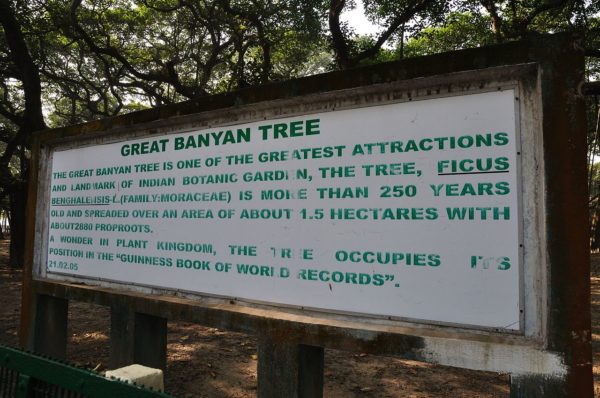The oldest citizen of the city, the 255-year-old Great Banyan at the Indian Botanic Garden, Shibpur – is, well, greater than ever before. In fact, the garden’s grand old crowd-puller has increased its girth by a massive two acres in a little over 30 years, forcing its caregivers to create a larger boundary railing to hold it in.
In 1985, when a fence was installed around the tree, it covered an area of three acres.Today , 32 years later, so many prop roots have grown all around that the total area covered is five acres. So, a new fence had to be put around the energetic senior citizen. This new fencing has just been completed, though senior scientists in charge of the tree’s health are not sure how long this, too, will be relevant. The Botanical Survey of India, which is the guardian of the garden, has already nicknamed the Great Banyan ‘The Walking Tree’.
The Guinness World Records mentions the Great Banyan as one that has the largest canopy and covers the widest circumference. The garden authorities have decided to write to the Guinness authorities about the tree’s latest feat, too. Now, the Great Banyan has over 4,000 prop roots that is keeping it alive, a wonder in itself, since the main trunk was lost to fungal infection way back in 1925. At the centre of the core area of the tree is an installation in memory of the lost trunk.
The tree is ‘walking’ towards the East, following the direction of the sunlight. “Apart from this eternal truth, you also have to remember that on the western side of the tree is also the boundary of the garden, beside which are residential buildings and a busy road, so the tree has avoided moving towards pollution,” said M U Sharief, curator of the garden and a senior botanist. We had done the earlier fencing in 1985 but the tree outgrew it soon, crossed the metalled road surrounding it and steadily kept moving east. Visitors would mutilate its prop roots by using them like swings; they would carve their names on the tree and even cut out portions to take away, following religious beliefs. These would have been fatal to this invaluable tree. So, we did away with the metalled road so that the prop roots could get firmly fixed on the ground and built a second fencing,” said M U Sharief, the garden’s curator.
There are 13 garden staffers who care exclusively for the tree. Of them, four are senior botanists and the rest are trained gardeners. They check every inch of the tree for signs of fungal infection, termite infestations and rotting. “We keep checking for lichen and moss cover on the tree because they are indicators of health,” said Basant Singh, another senior botanist.
But the biggest job at hand is to give the tree as many “legs” as possible to aid its run. There are hundreds of prop roots coming down from the tree. “Since the tree doesn’t have a main trunk, its weight is poised on the prop roots. Again, the growth is on one side, so we have to be additionally careful about balance,” Sharief explained.



Leave a reply